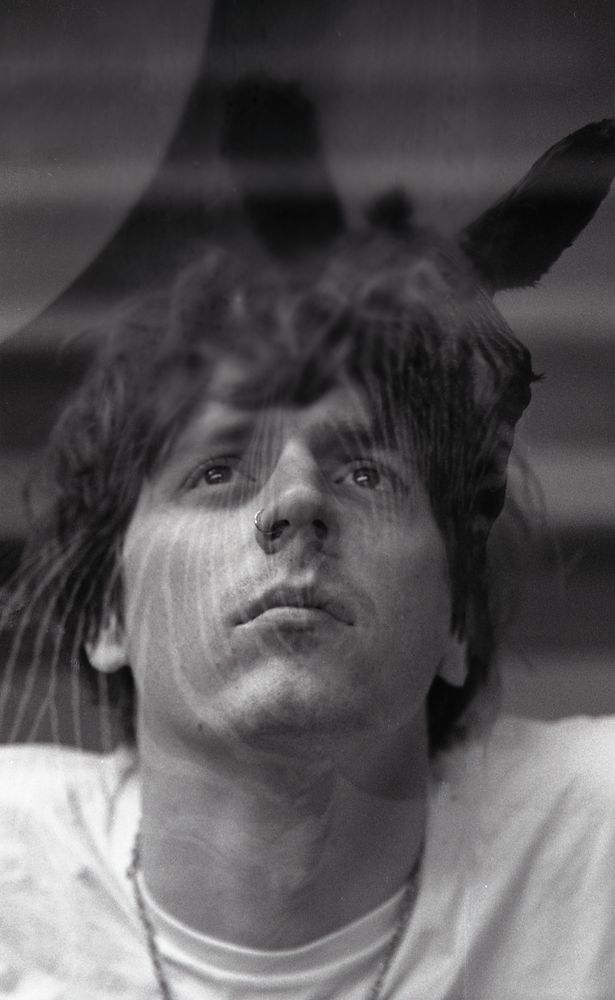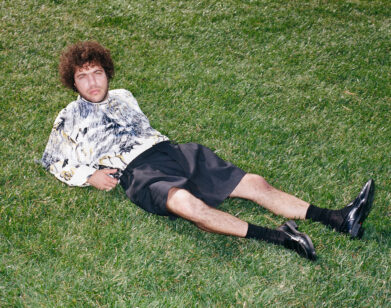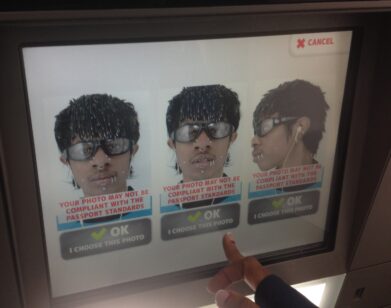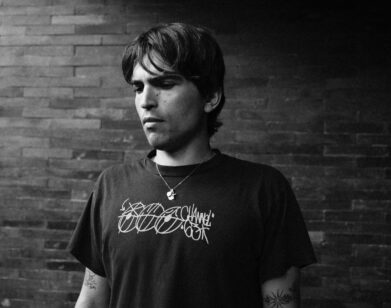At the Museum of Natural History with the Mystery Jets
Interview‘s meeting with the Mystery Jets began at a café in North London and ended with a photo shoot at the Natural History Museum, perusing the exhibits for the band’s “power animals.” We met to talk about the band’s fourth studio album, Radlands, which comes out this month. Radlands marks quite a transition for the ‘Jets, a band that emerged as part of the London indie-rock scene around 2005—a little before Interview favorites Noah and the Whale and Laura Marling (with whom the band has collaborated). Always a London-based band, the boys relocated to Texas to write and record their “version of a country album,” which developed into the story of the bands’ invented alter-ego, Emerson Lonestar, complete with a three-part comic book created with Richard Elms and illustrated by V. Kenneth Marion. When the group returned to London, their bassist, Kai Fish, publicly announced his resignation. As for whether this geographical and musical upheavel translate into a cohesive album; you need to loosen your image of the Mystery Jets as a band deeply rooted in London indie or you’ll spend the first few songs wondering why the Mystery Jets are singing the Eagles. Radlands takes a few songs to get used to, but somewhere between the unfortunately titled “You Had Me At Hello,” and ” Greatest Hits,” things begin to make sense. It’s definitely a new approach, but not as far removed from the “Alas Agnes” days as one might think. As guitarist William Rees assured us over brunch, “I think creativity comes out of conflict. The best things we’ve done have come out of very uncertain situations.”
EMMA BROWN: So, you said that you’re really busy.
BLAINE HARRISON: Yeah. We were in India in January. We were having a break, we spent most of last year recording and writing so we just wanted to get away and not have anything to do with music for a while. Since we’ve come back we’ve been running around mixing the record, mastering the record, getting all the art work together, which takes as long as the music for us. Your record is like your little baby and you end up agonizing over all the details. With this record we wrote more songs than for any other record, we’ve probably got about 20 or 25 songs, which we had to cut down to 11.
BROWN: What are you going to do with the songs that didn’t make the album?
HARRISON: I don’t know. It’s always a bit depressing that they end up as—some just fizzle away and disappear, some end up as B-sides, but I never feel like a B-side is enough of a justification for a song.
BROWN: Did you workshop the songs live as you were writing and recording? Or did you do everything in the studio?
HARRISON: With the last album we went to Berlin and we played a gig every night for seven days, but under a pseudonym, which was really good—it was like road-testing the album, but in a foreign country where people have no idea who you are. Normally when you have your tour, everyone’s there to see you and people have your record and sing along. [When we played in Berlin] we could tell which songs went down well, and the ones that went down really well made it onto the record, the ones that didn’t we threw away. We didn’t have time to do that on this album. This album was a completely different process to anything we’d done. We decamped to Texas and did the majority of the record in Austin.
BROWN: Why?
HARRISON: We’d always been a London band. We’d always lived here, we’d always recorded here, and we needed a change. London’s kind of lost. Nothing’s really happening here in music. It’s a bit in between things and it’s not a very exciting environment to be in.
BROWN: I feel like when you guys started it was kind of at the tail end of indie music being really popular, and now UK hip-hop and dubstep is sort of taking over popular music. That must be sort of strange for you.
HARRISON: Yeah, the whole dubstep thing came from London. We’ve done dance music in the past, but with this record we were like, “We want to make a folk record, a country record.” And it’s kind of turned out that way—the influence is definitely more American, so it made sense being over there. We kind of kept to ourselves, it was a very insular experience.
BROWN: You didn’t get horribly sick of each other?
HARRISON: Yeah, inevitably you do. But we’ve been playing in a band together since we were 15, 16, so we’ve had pretty much every squabble that you can have. Me and Will started the band when we were kids, when we were like, nine years old, with the same name. So the band’s existed since the mid-’90s.
BROWN: What was your first song called?
HARRISON: It was called “Tell Me, Jim” and it was about Jim Morrison, going to Jim Morrison’s grave in Père Lachaise and asking him lots of questions, “What is it like, living in heaven?”
BROWN: That was when you were nine or 10?
HARRISON: Yeah.
BROWN: You were a Jim Morrison fan already? That’s quite advanced. I try not to think about what I was listening to when I was nine. Do you ever revisit those early songs now?
HARRISON: Not really. We played at my dad’s 60th birthday last year, because we played at his 50th with the same lineup, and we played all our old songs from when we were 16, 17. It was really weird. Really cringe. But it was entertaining.
BROWN: What about songs that made it on to your early records, does it feel weird to play them now?
HARRISON: I think when you write a song, it’s an expression of what’s happening in your life at that point in time, and you’re not going to relate to that forever. I look back at our first record, and we might play one or two of those songs now. Even our second record, we maybe only play four of those songs. There definitely comes a point where it’s like, these are the words of a 21-year-old kid; even if other people want to hear them, if you don’t really relate to the songs, it kind of feels contrived singing them. Which is sad, because it means that there are songs that have disappeared, but they’ll come back one day. And I don’t think people want to hear the same songs forever.
BROWN: If you had to introduce someone to the Mystery Jets and were only allowed to play one song, which song would you play them?
HARRISON: Really hard to say. Our band’s been through so many incarnations. I think every record sounds really different, I mean, to someone else they might all sound the same, but to me they are coming from such different places and they’ve been influenced by such different eras of music. I’d kind of need to play them five songs and be like, “This has been our journey.” Possibly a song called “Zootime” on the first album. It says a lot about what we set out to do. We’ve moved really, really far away from that, which is a good thing, you have to evolve, but it came on the other day and it sounded so naïve and primitive, but there was something about it that was really captured—a little bit about the time it came out, 2005 and 2006.
BROWN: What made you decide to go to India?
HARRISON: It just seemed one of the furthest removed places from the Western world that we could go to, other than going to the middle of Afghanistan. And it was. Massive culture shock when we got there. But I loved it. We also started learning Indian music as well, we took Indian music classes. They have ragas there, which is kind of like Indian pop music. They call it Indian classical music, but it functions in the same way as pop music, with verses and choruses.
[Will Rees arrives]
BROWN: Hi, Will how are you doing?
WILL REES: I’m good. Ready to do the first interview for the new album.
BROWN: I heard that it was your version of a country record.
REES: Kind of, there are definitely some country influences on there, amongst other things.
BROWN: Blaine and I were talking about India, and I was wondering what sort of recreational activities you do when you’re on the road?
REES: We all have different things that we do. I like to go to bikram yoga, or walking around and getting to know the town.
HARRISON: [I] go to zoos. I love zoos, which is a bit strange because I’m a vegetarian.
BROWN: What’s the best zoo you’ve been to?
HARRISON: Singapore zoo. Singapore zoo is amazing. It’s got one bit that you can only see at night—the “night safari”—you go through on a little train and it’s all the animals that are nocturnal.
BROWN: You went twice, during the daytime and at night?
HARRISON: Yeah, I did both.
BROWN: Do you beeline towards a certain section of the zoo—the reptile house?
HARRISON: Monkeys. They’re kind of caricatures of human beings.
BROWN: I wouldn’t have thought that you’d get enough time to do all of this while on tour.
HARRISON: We make time. It’s very easy to let the day slip away. When we’ve toured Australia and America—places like that—we make an effort to go out. But when we tour England… there are only so many times that you can go and see.
REES: The aquarium in Blackburn.
[both laugh]
BROWN: [to Rees] I asked Blaine this earlier, but I want to know your answer as well. If you could only play one song to a stranger to introduce them to Mystery Jets, which song would you play them?
REES: [pause]
BROWN: Or would you refuse to play them any of your songs—all or nothing?
REES: I’d give it a shot. I think I’d play them “Radlands,” one of our new songs. [To Blaine] What did you say?
HARRISON: “Zootime.”
REES: Did you? They wouldn’t want to hear anything else after that.
HARRISON: Radlands is also what the album is going to be called—we have to decide today. The name Radlands was drawn out of Badlands, the movie with Martin Sheen. We saw the film and said “We want to make the record sound the way that looks.” Then “Redlands” was the name of Keith Richards’ house where the Stones got busted—the first big drug bust in the ’60s. The song “Radlands” was written before we went out to America, but I feel like it was written in imagination of what we wanted America to be—a fantasy about a couple who run away together to escape the police. They hide out in a little cabin by the lake, which is basically what we ended up in [when we were living in Texas].
We created this character called Emerson Lonestar. I think that’s what country music is, story telling. When we got back [to England] we realized that there was a story there, [our songs] were different chapters of a book—Lonestar became someone we could project all of these experiences onto, and he could live through all of the things that we actually lived through, but he could tell them from his own perspective. Then it made sense to take it a step further, which is what we did. There’s a comic book coming out with this record, a three-part comic book [illustrated by V. Kenneth Marion].
REES: Of course, Emerson Lonestar is basically an alter-ego of the band. All the songs are actually experiences we all had in America. It’s a weird kind of art is life and life is art relationship.
BROWN: When you have a narrative album, does it upset you that people probably won’t listen to the whole album, but just download certain songs?
REES: You don’t have to listen to it in that way. They are still 11 songs; they don’t need each other, necessarily. It’s not an essential thing that you take the album home and turn off the lights and listen to it. You can take it as you want.
HARRISON: A lot of my favorite films—David Lynch films or Almodóvar or Tarantino—it starts at the beginning, then goes to the end, they’ll be a flashforward and a dream sequence. That’s kind of how the record is; scrambled up. It’s not chronological. I think it lends itself well to the shuffle button on an iPod.
RADLANDS COMES OUT TODAY AND IS AVAILABLE TO PURCHASE ON AMAZON US STARTING MAY 8. FOR MORE INFORMATION, VISIT THE MYSTERY JETS’ WEBSITE.







